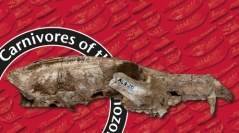

 Geodiversitas
41 (18) - Pages 663-677
Geodiversitas
41 (18) - Pages 663-677The locality of Çalta has yielded one of the richest collection of fossil canids belonging to the raccoon dog genus Nyctereutes Temminck, 1838. This locality is situated in central Anatolia and its age is determined as early Pliocene, c. 4 Ma. Ginsburg (1998) studied these canid remains and identified them as N. donnezani, which was previously known from some early Pliocene localities in southern France and Spain. Some later studies questioned this attribution. The present study provides a new description of all available material, housed in collections in Paris, Lyon and Ankara, and a detailed comparison of the cranial and dental characters with other known species of Nyctereutes. This study is completed by a cladistic analysis of cranial and dental characters to document the phylogenetic relationships of the Çalta raccoon dog. This analysis was done on the locality-based data, using the main occurrences of each species. Both morphological and cladistic analyses favour attribution of the Çalta raccoon dog to N. donnezani, in agreement with Ginsburg (1998). In addition, this study reveals that possible sexual dimorphism in the size and proportions of some cranial elements, such as stronger sagittal and nuchal crests, a better defined temporal line, a thicker zygomatic process of the maxillary bone, a braincase that is elongated but less round and, in particular, stronger subangular lobe in male individuals.
Canidae, Nyctereutes, Pliocene, Turkey, phylogeny, sexual dimorphism